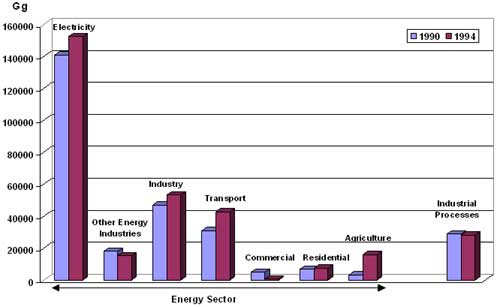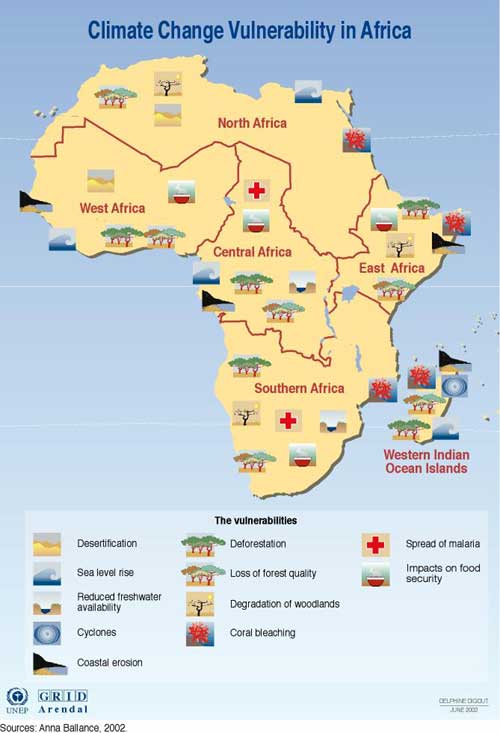Tiempo Climate Cyberlibrary
National Climate Strategy for South Africa
- Tiempo archive
- Complete issues
- Selected articles
- Cartoons
- Climate treaty
- Latest news
- Secretariat
- National reports
- IPCC
About the Cyberlibrary
The Tiempo Climate Cyberlibrary was developed by Mick Kelly and Sarah Granich on behalf of the Stockholm Environment Institute and the International Institute for Environment and Development, with sponsorship from the Swedish International Development Cooperation Agency.
While every effort is made to ensure that information on this site, and on other sites that are referenced here, is accurate, no liability for loss or damage resulting from use of this information can be accepted.
Newswatch editor Mick Kelly reports on the launch of South Africa's National Climate Change Response Strategy.
The Deputy Minister of Environmental Affairs and Tourism, Rejoice Mabudafhasi, launched South Africa's new National Climate Change Response Strategy on 7 October 2004 in Johannesburg. She said that the strategy would address the government's priorities of poverty eradication, job creation and sustainable economic, social and environmental development.
"It is quite clear that our struggle to fight against poverty and our mandate to manage the natural resources will be undermined unless climate change response strategies are developed and implemented at local, regional and continental levels to ensure that problems associated with climate change are dealt with in a proactive manner," she said.
Director-General of the Department of Environmental Affairs and Tourism, Chippy Olver, reported that "we are adopting an integrated climate change response strategy which maps out a detailed set of responsibilities for each department." According to Shirley Moroka, Deputy Director of Climate Change at the Department of Environmental Affairs and Tourism, the plan is aimed primarily at government departments who will use it as a basis for developing their own plans for integrating climate issues into their policy and practices.
The national strategy is based on the following principles:
- growing the economy and competitiveness within the globally-negotiated response to climate change;
- focusing on areas that promote sustainable development;
- the need to consistently use locally-available resources (coal);
- recognizing that South Africa's emissions will continue to increase as development is realized; and,
- recognizing that adaptation to the adverse impacts of climate change will be necessary.
Listing threats to South Africa posed by climate change, Olver concluded that "it's a grim picture." The country was getting hotter, drier in some places and wetter in others. Crop production would be affected. He warned that "within two generations, what we know as the maize triangle may no longer exist." Malaria could spread into previously malaria-free areas. The economy would suffer.
South Africa's vulnerability is exacerbated by the fact that the nation has a fossil fuel-based economy, is a coal exporter and has insufficient appropriate technology.
As far as mitigation is concerned, the strategy prioritizes the development of renewable energy. South Africa should obtain 10,000 gigawatt hours of energy from renewable sources by 2012. The strategy also calls for a national authority, under the Department of Minerals and Energy, to facilitate Clean Development Mechanism projects. South Africa needed to take advantage of new opportunities for funding and investment, Olver pointed out.
|
|
|
Greenhouse gas emissions, South Africa |
The main elements of the mitigation strategy are:
- implementing the Government's White Paper on Renewable Energy and the Energy Efficiency Strategy;
- developing a transport sector mitigation programme;
- developing a coal-mining sector mitigation programme;
- implementing sustainable industrial development;
- interventions to reduce greenhouse gas emissions in the agricultural sector;
- the establishment and extension of forest schemes; and,
- the optimization of waste management practices.
At the launch, Chippy Olver noted that, although progress was being made in reducing greenhouse gas emissions, there was less clarity with regard to dealing with the impacts of climate change and adaptive responses. The Department of Agriculture would develop "advisory packages" so that farmers would be aware of what their options were as climate alters.
|
|
|
Climate vulnerability in Africa |
The national strategy calls on the Department of Education to speed up education, training and awareness to facilitate the implementation of response actions. Relevant ministries would need to develop water resource management, adapt agricultural, rangeland and forestry practices appropriately and extend health protection and promotion measures to counter climate change-related health impacts.
The national strategy has been welcomed by most commentators, though there has been some criticism from non-governmental organizations on the grounds that the document does not go far enough. Bruce Hewitson of the University of Cape Town considers the strategy positive in principle, but he too has reservations. He argues that the plan "does not address the priorities or critical issues" and should be seen as a first step rather than a definitive solution.
"This strategy is not the end of the story," responded Joanne Wawitch, Deputy Director-General of the Department of Environmental Affairs and Tourism, to such comments. The government is starting work on a second document that will provide a concrete action plan.
|
News sources |
|
On the Web
South Africa's first National
Communication under the United Nations Framework
Convention on Climate Change is available online (1 Mb
download).
Acknowledgements
We thank Trodger Thebe of the South African Department of
Environmental Affairs and Tourism for providing material
for this report.
Bright Ideas

General Electric plans to cut solar installation costs by half

Project 90 by 2030 supports South African school children and managers reduce their carbon footprint through its Club programme

Bath & North East Somerset Council in the United Kingdom has installed smart LED carriageway lighting that automatically adjusts to light and traffic levels

The United States National Oceanic and Atmospheric Administration and the American Public Gardens Association are mounting an educational exhibit at Longwood Gardens showing the link between temperature and planting zones

The energy-efficient Crowne Plaza Copenhagen Towers hotel is powered by renewable and sustainable sources, including integrated solar photovoltaics and guest-powered bicycles
El Hierro, one of the Canary Islands, plans to generate 80 per cent of its energy from renewable sources

The green roof on the Remarkables Primary School in New Zealand reduces stormwater runoff, provides insulation and doubles as an outdoor classroom

The Weather Info for All project aims to roll out up to five thousand automatic weather observation stations throughout Africa

SolSource turns its own waste heat into electricity or stores it in thermal fabrics, harnessing the sun's energy for cooking and electricity for low-income families

The Wave House uses vegetation for its architectural and environmental qualities, and especially in terms of thermal insulation

The Mbale compost-processing plant in Uganda produces cheaper fertilizer and reduces greenhouse gas emissions

At Casa Grande, Frito-Lay has reduced energy consumption by nearly a fifth since 2006 by, amongst other things, installing a heat recovery system to preheat cooking oil
Updated: May 15th 2015

